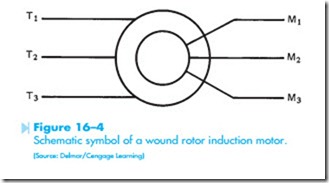MOTOR OPERATION
When power is applied to the stator winding, a rotating magnetic field is created in the motor. This magnetic field cuts through the windings of the rotor and induces a voltage into them. The amount of voltage induced in the rotor windings is determined by the same three factors that determined the amount of voltage induced in the squirrel-cage rotor. The amount of current flow in the rotor is determined by the amount of induced voltage and the amount of resistance connected to the rotor (I = E/R). When current flows through the rotor, a magnetic field is produced. This magnetic field is attracted to the rotating magnetic field of the stator.
As the rotor speed increases, the induced voltage decreases because of less cutting action between the rotor windings and rotating magnetic field. This produces less current flow in the rotor and, therefore, less torque. If resistance is reduced, more current can flow, which will increase motor torque, and the rotor will increase in speed. This action continues until the rotor is operating at maximum speed and all resistance has been shorted out of the rotor circuit. When all of the resistance has been
shorted out, the motor operates like a squirrel-cage induction motor.


